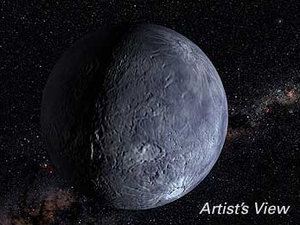50000 Quaoar
|
|
- This article is about the trans-Neptunian object. For the Tongva god, see Quaoar (deity).
| Discovery A (http://cfa-www.harvard.edu/iau/lists/NumberedMPs.html) | |
|---|---|
| Discoverer | Chadwick A. Trujillo, Michael E. Brown |
| Discovery date | June 4, 2002 |
| Alternate designations | 2002 LM60 B (http://cfa-www.harvard.edu/iau/MPDes.html) |
| Category | Kuiper belt |
| Orbital elements C (http://asteroid.lowell.edu/) Epoch October 22, 2004 (JD 2453300.5) | |
| Eccentricity (e) | 0.034 |
| Semi-major axis (a) | 6493.296 Gm (43.405 AU) |
| Perihelion (q) | 6270.316 Gm (41.914 AU) |
| Aphelion (Q) | 6716.275 Gm (44.896 AU) |
| Orbital period (P) | 104449.918 d (285.97 a) |
| Mean orbital speed | 4.52 km/s |
| Inclination (i) | 7.983° |
| Longitude of the ascending node (Ω) | 188.791° |
| Argument of perihelion (ω) | 154.850° |
| Mean anomaly (M) | 273.737° |
| Physical characteristics | |
| Dimensions | 989 - 1346 km |
| Mass | 1.0-2.6×1021 kg |
| Density | 2.0? g/cm³ |
| Surface gravity | 0.276-0.376 m/s² |
| Escape velocity | 0.523-0.712 km/s |
| Rotation period | ? d |
| Spectral class | ? |
| Absolute magnitude | 2.6 |
| Albedo | 0.10 |
| Mean surface temperature | ~43 K |
50000 Quaoar (pronounced kwah'-war, kwah'-wor, or kwow'-ur, Tongva ) [1] (http://www.gps.caltech.edu/~chad/quaoar) is a Trans-Neptunian object orbiting the Sun in the Edgeworth-Kuiper belt. It was discovered on June 4, 2002 by astronomers Chadwick A. Trujillo and Michael E. Brown at the California Institute of Technology in Pasadena, California from images acquired by Palomar Observatory using the JPL Near Earth Asteroid Tracking program. This discovery was announced on October 7, 2002, at a meeting of the American Astronomical Society. The earliest precovery turned out to be a July 17, 1982 plate from the Siding Spring Observatory 1.2 m telescope.
Quaoar is estimated to have a diameter of about 1,200 kilometres, which at the time of discovery made it the largest object found in the solar system since Pluto and, indeed, then the largest known minor planet (it was later supplanted by 90377 Sedna). More massive than all of the asteroids put together, it is about one tenth the diameter of Earth or one third the diameter of the Moon. It orbits at about 6 billion kilometres from the Sun with an orbital period of 286 years.
The planetoid's name follows International Astronomical Union rules by naming all planetoids after creation deities (see planetary nomenclature). "Quaoar" is the name of a creation deity of the Native American Tongva people, native to the area around Los Angeles, where the discovery was named. The IAU approved the name Quaoar, making it the official name; it also has the systematic name 2002 LM60.
The discovery weakens Pluto's case to be classed as a planet, since astronomers expect that there may be as many as a dozen Kuiper Belt objects the size of Quaoar. Or it may require a change to the definition of planet to include Pluto, Quaoar, and Sedna. Some expect to find planetoids larger than Pluto. In some ways, Quaoar has more claim to be a planet than Pluto does: it has a more typical planetary orbit (a near-circular orbit with a radius of somewhat over 40 AU rather than a highly eccentric one like Pluto's). Like Neptune, Quaoar's orbit lies between Pluto's perihelion and aphelion, so that Pluto is closer to the Sun than Quaoar at some times of its year, and farther at others.
Quaoar is believed to be a mixture of rock and ice, like other Kuiper Belt Objects; however its extremely low albedo (estimated at 0.1) indicates that the ice has disappeared from its outer layers. After the New Horizons mission visits Pluto (in 2015) and goes on to visit several Kuiper Belt Objects our knowledge of such things should greatly improve.
In 2004, scientists were surprised to find signs of crystaline ice on Quaoar, indicating that the temperature rose to at least −160°C (110 K or −260°F) sometime in the last ten million years. Speculation began as to what could have caused Quaoar to heat up from its natural temperature of −220°C (55 K or −360°F). Some have theorized that a barrage of mini-meteors may have raised the temperature, but the most discussed theory speculates that cryovolcanism may be occurring, spurred by the decay of radioactive elements within Quaoar's core.
External links
- Quaoar discoverers' webpage (http://www.gps.caltech.edu/~chad/quaoar/)
- Astronomers Contemplate Icy Volcanoes in Far Places (http://www.nytimes.com/2004/12/09/science/09ice.html?ex=1260334800&en=9326ecdbb6f20b0a&ei=5090&partner=rssuserland*) - New York Times article
- An article in an Australian science magazine (http://www.theage.com.au/articles/2002/10/07/1033538894512.html)
- An article in National Geographic (http://news.nationalgeographic.com/news/2002/10/1003_021007_quaoar.html)
- Volcanoes on Quaoar at CNN.com (http://www.cnn.com/2004/TECH/space/12/08/volcano.neptune/index.html)
| The minor planets |
| Vulcanoids | Main belt | Groups and families | Near-Earth objects | Jupiter Trojans |
| Centaurs | Trans-Neptunians | Damocloids | Comets | Kuiper belt | Oort cloud |
| (For other objects and regions, see: Binary asteroids, Asteroid moons and the Solar system) |
| (For a complete listing, see: List of asteroids. For pronunciation, see: Pronunciation of asteroid names.) |
de:Quaoar es:(50000) Quaoar fr:50000 Quaoar it:Quaoar nl:Quaoar pt:Quaoar (planetóide) ru:Квавар sv:Quaoar

